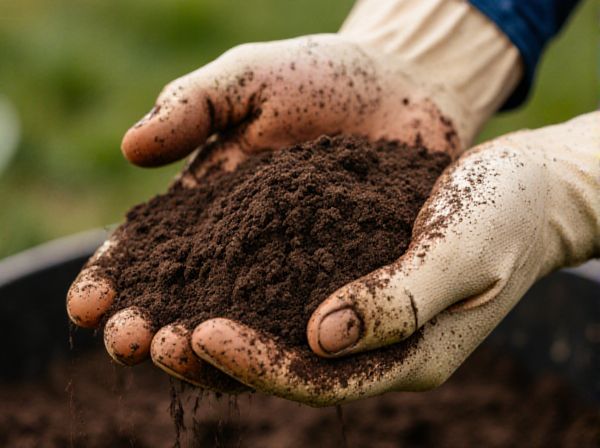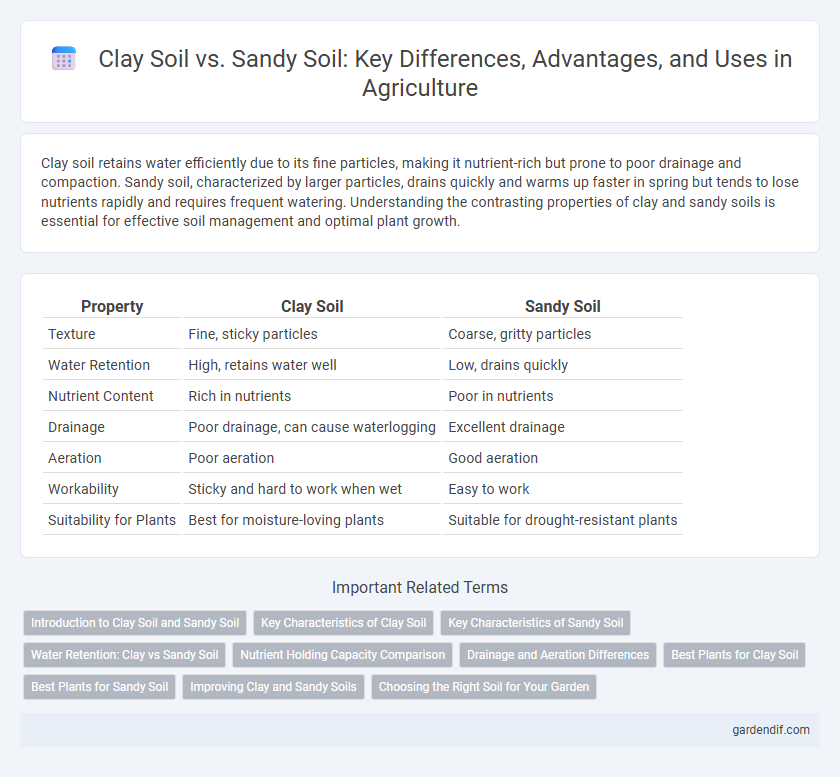
Clay soil vs Sandy soil Illustration
Clay soil retains water efficiently due to its fine particles, making it nutrient-rich but prone to poor drainage and compaction. Sandy soil, characterized by larger particles, drains quickly and warms up faster in spring but tends to lose nutrients rapidly and requires frequent watering. Understanding the contrasting properties of clay and sandy soils is essential for effective soil management and optimal plant growth.
Table of Comparison
| Property | Clay Soil | Sandy Soil |
|---|---|---|
| Texture | Fine, sticky particles | Coarse, gritty particles |
| Water Retention | High, retains water well | Low, drains quickly |
| Nutrient Content | Rich in nutrients | Poor in nutrients |
| Drainage | Poor drainage, can cause waterlogging | Excellent drainage |
| Aeration | Poor aeration | Good aeration |
| Workability | Sticky and hard to work when wet | Easy to work |
| Suitability for Plants | Best for moisture-loving plants | Suitable for drought-resistant plants |
Introduction to Clay Soil and Sandy Soil
Clay soil consists of very fine mineral particles that are tightly packed, resulting in poor drainage and high water retention. Sandy soil is composed of larger particles, allowing for excellent drainage but low nutrient retention and faster drying. Understanding these fundamental differences helps in optimizing soil management for plant growth and agricultural productivity.
Key Characteristics of Clay Soil
Clay soil is characterized by its fine texture, high nutrient content, and strong water retention capabilities, making it dense and heavy. It has poor drainage, which leads to slow drying and potential waterlogging, but it also holds nutrients well, supporting plant growth. The soil particles pack closely together, resulting in low aeration and increased compaction compared to sandy soil.
Key Characteristics of Sandy Soil
Sandy soil is characterized by large particle sizes ranging from 0.05 to 2.0 mm, providing excellent drainage and aeration but poor water and nutrient retention. Its coarse texture leads to rapid water infiltration, making it prone to drought stress for plants. Low organic matter content and minimal cation exchange capacity limit its fertility compared to clay soil.
Water Retention: Clay vs Sandy Soil
Clay soil exhibits high water retention due to its fine particles and dense structure, which effectively hold moisture but drain slowly, often leading to waterlogging. Sandy soil has large particles and porous texture, allowing rapid drainage and low water retention, which can cause plants to dry out quickly. Understanding these differences helps optimize irrigation practices and crop selection based on soil type.
Nutrient Holding Capacity Comparison
Clay soil exhibits a higher nutrient holding capacity compared to sandy soil due to its fine particle size and greater surface area, which allows it to retain essential minerals and nutrients effectively. Sandy soil, characterized by larger particles and larger pore spaces, tends to have poor nutrient retention, leading to faster leaching of nutrients like nitrogen, potassium, and phosphorus. Farmers and gardeners often amend sandy soils with organic matter to improve nutrient holding capacity and enhance soil fertility.
Drainage and Aeration Differences
Clay soil retains water due to its fine particles and poor drainage, leading to slower air movement and potential root suffocation. Sandy soil features larger particles with high permeability, promoting rapid drainage and enhanced aeration that benefits root respiration. Effective plant growth depends on balancing these drainage and aeration properties inherent in clay and sandy soils.
Best Plants for Clay Soil
Clay soil retains moisture and nutrients effectively, making it ideal for plants like hostas, daylilies, and coneflowers that thrive in dense, wet conditions. These plants benefit from the soil's fine texture and high organic matter content, which supports robust root development. Gardeners should avoid plants requiring well-drained soil, as clay can cause waterlogging and root rot.
Best Plants for Sandy Soil
Sandy soil, characterized by large particles and excellent drainage, supports drought-tolerant plants such as lavender, rosemary, and sedum that thrive in well-aerated conditions. These plants benefit from sandy soil's quick drying properties, which prevent root rot and fungal diseases common in heavier soils like clay. Optimal growth in sandy soil also requires occasional organic matter additions to retain moisture and nutrients for plants like thyme and coneflower.
Improving Clay and Sandy Soils
Improving clay soil involves incorporating organic matter such as compost or aged manure to enhance drainage and nutrient retention, while avoiding compaction by minimizing heavy machinery use. Sandy soil benefits from adding organic materials to increase water retention and nutrient-holding capacity, alongside applying mulch to reduce evaporation and maintain soil moisture. Regular soil testing guides precise amendments, ensuring balanced pH and essential micronutrients for optimal plant growth in both soil types.
Choosing the Right Soil for Your Garden
Clay soil retains moisture and nutrients effectively, making it ideal for water-loving plants but may require amendments to improve drainage. Sandy soil drains quickly and warms up faster in spring, benefiting plants that prefer well-aerated roots but often necessitates added organic matter to enhance fertility. Selecting the right soil depends on the specific water retention and nutrient needs of your garden plants, ensuring optimal growth and health.
Clay soil vs Sandy soil Infographic

 gardendif.com
gardendif.com